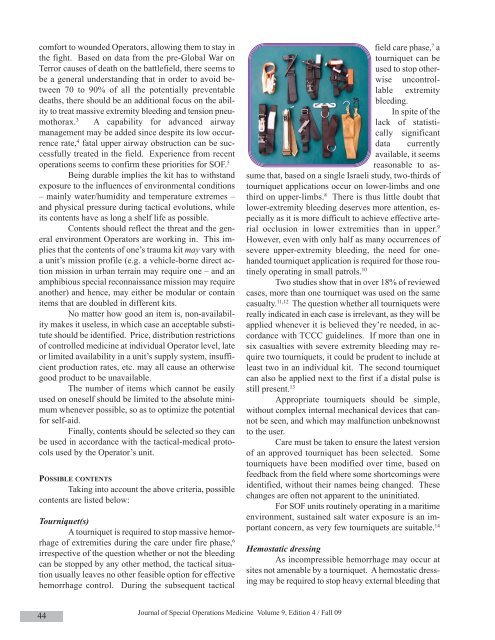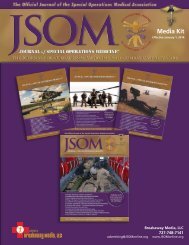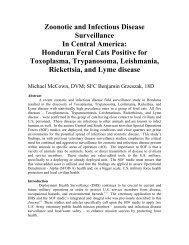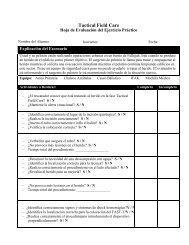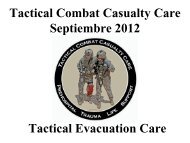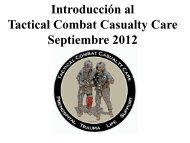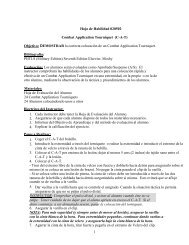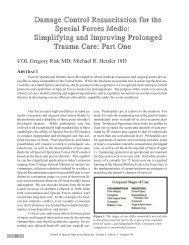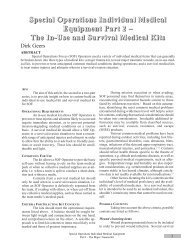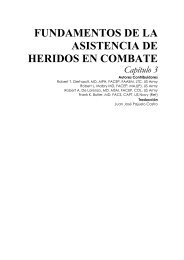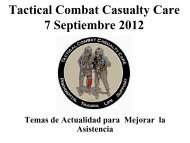Part One - The Major Trauma Kit. 09(4). - Journal of Special ...
Part One - The Major Trauma Kit. 09(4). - Journal of Special ...
Part One - The Major Trauma Kit. 09(4). - Journal of Special ...
Create successful ePaper yourself
Turn your PDF publications into a flip-book with our unique Google optimized e-Paper software.
comfort to wounded Operators, allowing them to stay in<br />
the fight. Based on data from the pre-Global War on<br />
Terror causes <strong>of</strong> death on the battlefield, there seems to<br />
be a general understanding that in order to avoid between<br />
70 to 90% <strong>of</strong> all the potentially preventable<br />
deaths, there should be an additional focus on the ability<br />
to treat massive extremity bleeding and tension pneumothorax.<br />
3 A capability for advanced airway<br />
management may be added since despite its low occurrence<br />
rate, 4 fatal upper airway obstruction can be successfully<br />
treated in the field. Experience from recent<br />
operations seems to confirm these priorities for SOF. 5<br />
Being durable implies the kit has to withstand<br />
exposure to the influences <strong>of</strong> environmental conditions<br />
– mainly water/humidity and temperature extremes –<br />
and physical pressure during tactical evolutions, while<br />
its contents have as long a shelf life as possible.<br />
Contents should reflect the threat and the general<br />
environment Operators are working in. This implies<br />
that the contents <strong>of</strong> one’s trauma kit may vary with<br />
a unit’s mission pr<strong>of</strong>ile (e.g. a vehicle-borne direct action<br />
mission in urban terrain may require one – and an<br />
amphibious special reconnaissance mission may require<br />
another) and hence, may either be modular or contain<br />
items that are doubled in different kits.<br />
No matter how good an item is, non-availability<br />
makes it useless, in which case an acceptable substitute<br />
should be identified. Price, distribution restrictions<br />
<strong>of</strong> controlled medicine at individual Operator level, late<br />
or limited availability in a unit’s supply system, insufficient<br />
production rates, etc. may all cause an otherwise<br />
good product to be unavailable.<br />
<strong>The</strong> number <strong>of</strong> items which cannot be easily<br />
used on oneself should be limited to the absolute minimum<br />
whenever possible, so as to optimize the potential<br />
for self-aid.<br />
Finally, contents should be selected so they can<br />
be used in accordance with the tactical-medical protocols<br />
used by the Operator’s unit.<br />
POSSIBLE CONTENTS<br />
Taking into account the above criteria, possible<br />
contents are listed below:<br />
Tourniquet(s)<br />
A tourniquet is required to stop massive hemorrhage<br />
<strong>of</strong> extremities during the care under fire phase, 6<br />
irrespective <strong>of</strong> the question whether or not the bleeding<br />
can be stopped by any other method, the tactical situation<br />
usually leaves no other feasible option for effective<br />
hemorrhage control. During the subsequent tactical<br />
field care phase, 7 a<br />
tourniquet can be<br />
used to stop otherwise<br />
uncontrollable<br />
extremity<br />
bleeding.<br />
In spite <strong>of</strong> the<br />
lack <strong>of</strong> statistically<br />
significant<br />
data currently<br />
available, it seems<br />
reasonable to assume<br />
that, based on a single Israeli study, two-thirds <strong>of</strong><br />
tourniquet applications occur on lower-limbs and one<br />
third on upper-limbs. 8 <strong>The</strong>re is thus little doubt that<br />
lower-extremity bleeding deserves more attention, especially<br />
as it is more difficult to achieve effective arterial<br />
occlusion in lower extremities than in upper. 9<br />
However, even with only half as many occurrences <strong>of</strong><br />
severe upper-extremity bleeding, the need for onehanded<br />
tourniquet application is required for those routinely<br />
operating in small patrols. 10<br />
Two studies show that in over 18% <strong>of</strong> reviewed<br />
cases, more than one tourniquet was used on the same<br />
casualty. 11,12 <strong>The</strong> question whether all tourniquets were<br />
really indicated in each case is irrelevant, as they will be<br />
applied whenever it is believed they’re needed, in accordance<br />
with TCCC guidelines. If more than one in<br />
six casualties with severe extremity bleeding may require<br />
two tourniquets, it could be prudent to include at<br />
least two in an individual kit. <strong>The</strong> second tourniquet<br />
can also be applied next to the first if a distal pulse is<br />
still present. 13<br />
Appropriate tourniquets should be simple,<br />
without complex internal mechanical devices that cannot<br />
be seen, and which may malfunction unbeknownst<br />
to the user.<br />
Care must be taken to ensure the latest version<br />
<strong>of</strong> an approved tourniquet has been selected. Some<br />
tourniquets have been modified over time, based on<br />
feedback from the field where some shortcomings were<br />
identified, without their names being changed. <strong>The</strong>se<br />
changes are <strong>of</strong>ten not apparent to the uninitiated.<br />
For SOF units routinely operating in a maritime<br />
environment, sustained salt water exposure is an important<br />
concern, as very few tourniquets are suitable. 14<br />
Hemostatic dressing<br />
As incompressible hemorrhage may occur at<br />
sites not amenable by a tourniquet. A hemostatic dressing<br />
may be required to stop heavy external bleeding that<br />
44<br />
<strong>Journal</strong> <strong>of</strong> <strong>Special</strong> Operations Medicine Volume 9, Edition 4 / Fall <strong>09</strong>


